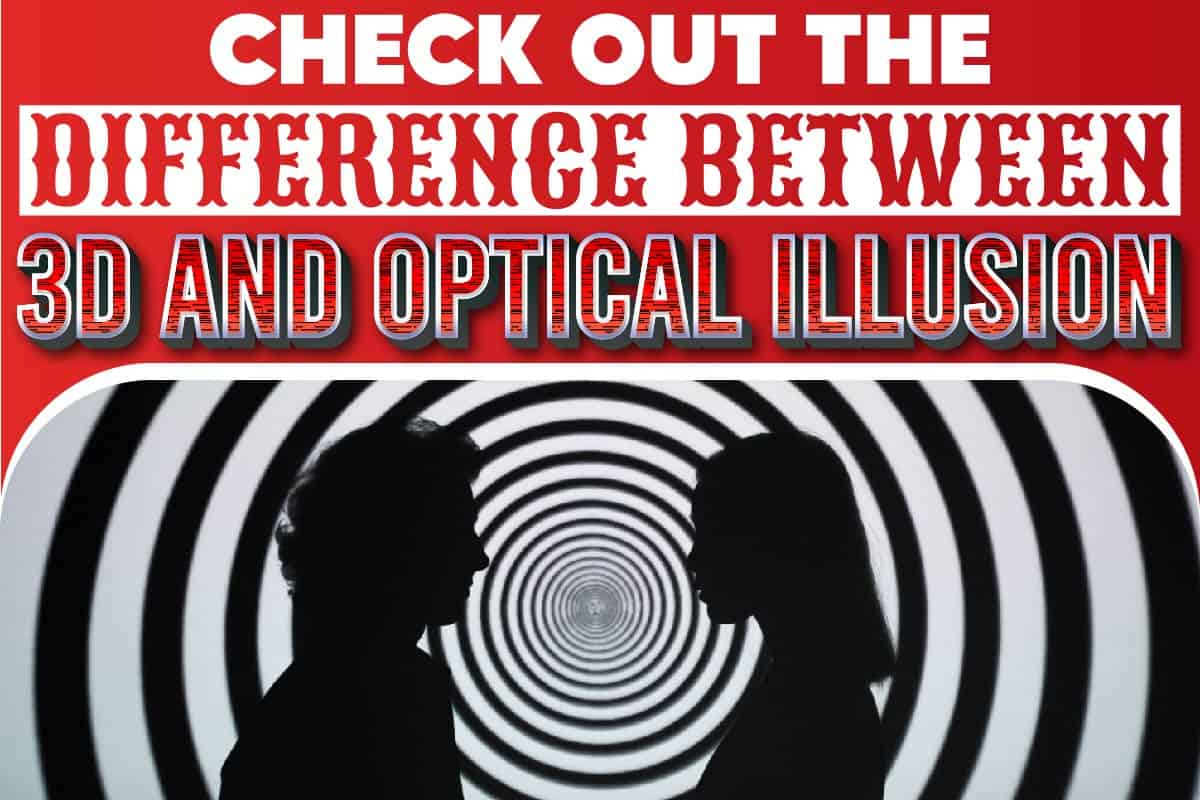Illusions are incorrect perceptions of stimuli that can reveal how our brain organizes and perceives sensory information.
An optical illusion is one important method used by neuroscientists to understand how our brain produces its perception of reality.
Visual deception is a component of optical illusions. You may notice a wide range of misleading visual illusions due to the arrangement of the images, color effects, the impact of the light source, and other elements.
3D illusion is a type of illusion in which the brain interprets a two-dimensional image as three-dimensional.
So, is there a difference between the two concepts – 3D illusion and optical illusion?
Difference Between 3D And Optical illusion
An optical illusion is a broad term for all types of visual illusions. 3D illusion is an optical illusion that makes you perceive images as though you can touch them.
Types Of Optical Illusions
Physical visual illusions:
These are produced by viewing physical objects from a distance or through a medium.
An example is when the sun appears smaller than the earth or a seemingly broken spoon in a glass filled with water.
Physiological visual illusions:
These illusions are produced when we view images after the eye has been exposed to intensive alternating patterns.
These repeated images tend to create a physiological imbalance that alters perception. An example is the Hermann grid illusion.
Cognitive optical illusions:
These illusions tend to come from our biases and lead to false conclusions. They include ambiguous, distorting, paradoxical, or fiction illusions.
Ambiguous illusions allow us to have different perceptions of one image from different perspectives.
Distorting illusions tend to affect shape, size, and length. They make us perceive these dimensions differently from reality.
Paradox illusions create images that are supposed to be impossible, depending on how these things should be shaped. An example is the Penrose Triangle.
Fiction illusion is the perception of an object that is not there. When this happens, we say our mind is playing tricks on us.
List Of Visual Illusions
Afterimages:
This occurs when you continue to see an image even after the original image is no longer there. It can be called a ghost image.
Afterimages are a response to stimulation of the eye. This stimulation is so much that the photochemical activity in the eye still occurs after the source of stimulation is taken away.
We may have experienced these illusions after focusing on a strong light source. There are two types of afterimage illusions, positive and negative afterimage illusions.
Color dove illusion:
Afterimages often occur to resemble the complementary color of the stimulation source.
When a white “empty” shape is placed on a background and used to stimulate the eye, the afterimage takes the color of the background when the background is taken out.
The following can be responsible for the color dove illusion, which is so named because the dove represents an “empty” shape.
- When we observe the empty shape, the background color may force us to perceive the empty shape as having the complementary color of the background.
When you remove that background, the empty image tends to have a complementary color of the perceived color, which coincides with the background.
- When taken away it could be that the background induces an afterimage, which has a complementary color. This afterimage then induces a complementary color on the “empty” shape.
Ambiguous image:
This image depicts two different things, depending on how you look at it. So in different instances, people see things differently.
It takes advantage of the visual similarities and other visual factors between two or more objects. It is also known as a reversible image.
This ambiguity makes it possible for a single image to have stable but multiple perceptions. It is often used for psychological research purposes.
When we perceive images, we first have to identify the basic features, classify them, and then identify them.
The above steps are called early-level vision, mid-level vision, and high-level vision, respectively. The last two are very important in resolving ambiguous images.
Ames room illusion:
This room has a hexahedron design but looks like a standard quadrilateral room when viewed through a peephole.
The room is designed such that our eyes do not perceive the true details of the room. The moment it becomes perceived as a normal room, the illusion occurs.
The main feature responsible for this is the peephole. The peephole does three things.
- It is positioned such that what the eye perceives is an ordinary room. From any other angle, you can see the true shape of the room.
- The observer is forced to view the room with a single eye. As a result, binocular vision is impossible, and this could affect the sense of depth.
- It doesn’t allow the observer to note the room from different directions as the observer cannot move his eye.
The designer also employs other tools to carry out this deception, like strategic lighting.
The illusion affects both the shape of the room and the perception of object size and actual positioning. You can also achieve it with the creation of just a horizon and a background.
Ambigram:
A calligraphic design can be interpreted in multiple ways. Ambigrams may read the same in any direction or change interpretation based on perspective.
Ambigrams feature in many early historical writings even before the name was coined. They have also featured quite heavily in pop culture.
There are ways to generate ambigrams with computers, but they often are limited and fall short of handcrafted ambigrams.
There are many types of ambigrams, they include:
3D ambigrams:
These are constructed using solid geometry. They allow the viewer to see different words when observed in different directions.
Figure-ground:
In this type of ambigram, the space between letters of a word form entirely different words.
Mirror image:
Historically, this is probably the most popular implementation of the illusion. Mirror images usually show the same word when viewed in the mirror, that is, when viewed backward.
Multi-lingual:
This ambigram can be read in different languages depending on the direction. They can exist in all the other forms or types of ambigrams.
Natural ambigrams:
These are words which when written without any clever calligraphic manipulation, possess the qualities of an ambigram.
Bud written in small letters as “bud” is a natural mirror ambigram. Swims written “swims” is a natural rotational ambigram.
These tend to be a major component of certain modern puzzle games today.
Rotational ambigram:
These ambigrams can display different words or the same words when rotated through an angle.
Depending on the design, this angle may be 180 degrees, 90 degrees, or 45 degrees. 180 -degree ambigrams are the most popular kinds of rotational ambigrams.
Ames trapezoid window illusion:
This employs a window designed in the shape of a trapezium. This trapezium window is hung and spun around to create the illusion that it rotates at less than 180 degrees.
The trapezoidal shape is usually not perceived by the observer. The observer tends to believe it is a normal rectangular window.
This trick makes it seem like the window stops rotation at a point and reverses direction, creating a false perception of oscillation instead of rotation about a fixed point.
These illusions helped psychologists theorize that our expectations can influence our conclusions on things around us, especially when they are not clear.
Autokinetic effect:
This occurs when a stationary object appears to move of its own accord.
This movement is believed to occur because we perceive motion regarding a reference point, and in dark or featureless environments, references are difficult to perceive.
In the above instances, the position of single objects becomes difficult to define. This phenomenon is used to define the effects of suggestion or social influence on the mind.
Beta’s movement:
This gives the observer a false conclusion and senseless attack to ⁶89of motion of an object by showing subsequent images of a similar object at a particular frame rate.
This technique is widely employed in movies and animation. They are also employed in some LED displays to make us believe words or images are moving.
Figure-ground:
This organization is very important for identifying images from a background as human beings.
Figure-ground is based on certain biases such as shape outline or the belief that the image is usually smaller than the background.
A very famous example of this type of visual illusion is the Rubin vase. It challenges this ability to define objects and backgrounds.
Conclusion
Illusions are things that play on some of the weaknesses of the human senses. They can help create experiences or false interpretations.
Optical Illusions are the most popular, and 3D illusions are illusions that apply optical illusion techniques.
They make observers perceive images as physical objects. There are majorly three types of Optical Illusions; physical, physiological, and cognitive illusions.
These illusions are applied in different ways to create various experiences and they have been used to determine certain psychological conclusions and even entertainment.
Most of these illusions play on our biases and the probability of creating conclusions that may defer from reality.
You May Like These Articles As Well:
 Being Human
Being Human




